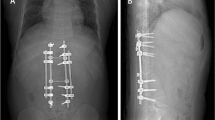Abstract
Introduction
Hypertrophy of the calvarium has different aetiologies, among them the rare Proteus syndrome.
Case report
We report here the case of a young girl initially treated for relapsing right then left large chronic subdural haematoma, who progressively developed craniofacial hypertrophy consistent with the diagnosis of Proteus syndrome. Calvarium hypertrophy was shaved and remodelled combining midface advancement, essentially for cosmetic purposes. During the first calvarium remodelling, important bleeding of the bone required large volume of blood replacement. Haemostasis workup revealed platelets aggregation anomalies. Bleeding issues during subsequent surgeries were controlled with tranexamic acid and desmopressin acetate.
Discussion
Other manifestations of Proteus syndrome, such as a right hypertrophy of the face with hypoplasia of its middle third, a pigmented epidermal nevus and asymmetric limbs and scoliosis, appeared progressively over time. Blood and fibroblast phosphatase and tensin homolog mutation was not found.
Conclusion
Literature review of operated patients with Proteus syndrome did not reveal an association with platelets anomalies. A complete haemostasis workup following this unexpected haemorrhagic complication is recommended for this rare pathology.



Similar content being viewed by others
References
Adolphs N, Tinschert S, Bier J, Klein M (2004) Craniofacial hyperostoses in Proteus syndrome—a case report. J Craniomaxillofac Surg 32(6):391–394. doi:10.1016/j.jcms.2004.06.007
Ali AA, Al-Najjadah I (2006) Surgical treatment of an unusual patient with Proteus syndrome. J Craniofac Surg 17(1):175–178
Barker K, Martinez A, Wang R, Bevan S, Murday V, Shipley J, Houlston R, Harper J (2001) PTEN mutations are uncommon in Proteus syndrome. J Med Genet 38(7):480–481
Becktor KB, Becktor JP, Karnes PS, Keller EE (2002) Craniofacial and dental manifestations of Proteus syndrome: a case report. Cleft Palate Craniofac J 39(2):233–245. doi:10.1597/1545-1569(2002)039<0233:CADMOP>2.0.CO;2
Biesecker LG (2001) The multifaceted challenges of Proteus syndrome. JAMA 285(17):2240–2243
Biesecker LG, Happle R, Mulliken JB, Weksberg R, Graham JM Jr, Viljoen DL, Cohen MM Jr (1999) Proteus syndrome: diagnostic criteria, differential diagnosis, and patient evaluation. Am J Med Genet 84(5):389–395. doi:10.1002/(SICI)1096-8628(19990611)84:5<389::AID-AJMG1>3.0.CO;2-O
Bilkay U, Tokat C, Ozek C, Gundogan H, Erdem O, Gurler T, Cagdas A (2003) Proteus syndrome. Scand J Plast Reconstr Surg Hand Surg 37(5):307–310
Choi JW (2002) Incidence of nonresponsiveness to epinephrine in platelets from healthy humans. Acta Haematol 108(2):106–108
Chow LM, Baker SJ (2006) PTEN function in normal and neoplastic growth. Cancer Lett 241(2):184–196. doi:10.1016/j.canlet.2005.11.042
Cohen MM Jr (1993) Proteus syndrome: clinical evidence for somatic mosaicism and selective review. Am J Med Genet 47(5):645–652. doi:10.1002/ajmg.1320470514
Cohen MM Jr, Hayden PW (1979) A newly recognized hamartomatous syndrome. Birth Defects Orig Artic Ser 15(5B):291–296
Dandine JB, James S, Van Garsse A, Born JD (2007) Intracranial hypertension in Proteus syndrome. Neurochirurgie 53(5):339–342. doi:10.1016/j.neuchi.2007.06.001
De Souza RA (2011) Origins of the elephant man: mosaic somatic mutations cause Proteus syndrome. Clin Genet 81(2):123–124. doi:10.1111/j.1399-0004.2011.01807.x
DeLone DR, Brown WD, Gentry LR (1999) Proteus syndrome: craniofacial and cerebral MRI. Neuroradiology 41(11):840–843
Dlouhy BJ, Menezes AH (2011) Osteopetrosis with Chiari I malformation: presentation and surgical management. J Neurosurg Pediatr 7(4):369–374. doi:10.3171/2011.1.PEDS10353
Hutspardol S, Chuansamrit A, Soisamrong A (2010) Spontaneous subgaleal hemorrhage in a girl with impaired adrenaline-induced platelet aggregation. J Med Assoc Thai 93(5):625–628
Joshi U, van der Sluijs JA, Teule GJ, Pijpers R (2005) Proteus syndrome: a rare cause of hemihypertrophy and macrodactyly on bone scanning. Clin Nucl Med 30(9):604–605
Katsaros D, Grundfest-Broniatowski S (1998) Successful management of visceral Klippel–Trenaunay–Weber syndrome with the antifibrinolytic agent tranexamic acid (cyclocapron): a case report. Am Surg 64(4):302–304
Legendre CM, Charpentier-Cote C, Drouin R, Bouffard C (2011) Neurofibromatosis type 1 and the “elephant man's” disease: the confusion persists: an ethnographic study. PLoS One 6(2):e16409. doi:10.1371/journal.pone.0016409
Lindhurst MJ, Sapp JC, Teer JK, Johnston JJ, Finn EM, Peters K, Turner J, Cannons JL, Bick D, Blakemore L, Blumhorst C, Brockmann K, Calder P, Cherman N, Deardorff MA, Everman DB, Golas G, Greenstein RM, Kato BM, Keppler-Noreuil KM, Kuznetsov SA, Miyamoto RT, Newman K, Ng D, O'Brien K, Rothenberg S, Schwartzentruber DJ, Singhal V, Tirabosco R, Upton J, Wientroub S, Zackai EH, Hoag K, Whitewood-Neal T, Robey PG, Schwartzberg PL, Darling TN, Tosi LL, Mullikin JC, Biesecker LG (2011) A mosaic activating mutation in AKT1 associated with the Proteus syndrome. N Engl J Med 365(7):611–619. doi:10.1056/NEJMoa1104017
Lublin M, Schwartzentruber DJ, Lukish J, Chester C, Biesecker LG, Newman KD (2002) Principles for the surgical management of patients with Proteus syndrome and patients with overgrowth not meeting Proteus criteria. J Pediatr Surg 37(7):1013–1020
Manquillo A, Martinez-Mena J, Quintana P, Paradinas F, Saez J, Revilla C, Galan JM (1997) Neurophysiological aspects of Proteus syndrome. Rev Neurol 25(146):1572–1574
Nguyen D, Turner JT, Olsen C, Biesecker LG, Darling TN (2004) Cutaneous manifestations of Proteus syndrome: correlations with general clinical severity. Arch Dermatol 140(8):947–953. doi:10.1001/archderm.140.8.947
Sakamoto Y, Nakajima H, Kishi K, Shimizu R, Nakajima T (2010) Management of craniofacial hyperostosis in Proteus syndrome. J Craniofac Surg 21(2):414–418. doi:10.1097/SCS.0b013e3181cfa7f0
Smith JM, Kirk EP, Theodosopoulos G, Marshall GM, Walker J, Rogers M, Field M, Brereton JJ, Marsh DJ (2002) Germline mutation of the tumour suppressor PTEN in Proteus syndrome. J Med Genet 39(12):937–940
Stricker S (1992) Musculoskeletal manifestations of Proteus syndrome: report of two cases with literature review. J Pediatr Orthop 12(5):667–674
Vaughn RY, Selinger AD, Howell CG, Parrish RA, Edgerton MT (1993) Proteus syndrome: diagnosis and surgical management. J Pediatr Surg 28(1):5–10
Zhou X, Hampel H, Thiele H, Gorlin RJ, Hennekam RC, Parisi M, Winter RM, Eng C (2001) Association of germline mutation in the PTEN tumour suppressor gene and Proteus and Proteus-like syndromes. Lancet 358(9277):210–211
Acknowledgments
We thank the parents for allowing us to report on their child's problems and for having given their written informed consent for publication of their daughter's photographs.
Author information
Authors and Affiliations
Corresponding author
Rights and permissions
About this article
Cite this article
El Hassani, Y., Jenny, B., Pittet-Cuenod, B. et al. Proteus syndrome revealing itself after the treatment of a bilateral subdural haematoma. Childs Nerv Syst 29, 1927–1931 (2013). https://doi.org/10.1007/s00381-013-2090-z
Received:
Accepted:
Published:
Issue Date:
DOI: https://doi.org/10.1007/s00381-013-2090-z




